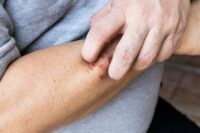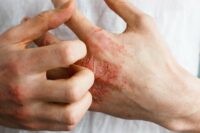Itching wounds are a common experience, often leaving you wondering why do wounds itch? This sensation, known as pruritus, is often a sign that your body is actively repairing itself, indicating the complex healing cascade is underway, learn more at WHY.EDU.VN. Managing this itchiness effectively involves understanding the underlying causes and implementing strategies to alleviate discomfort. Addressing wound itching also involves related concepts like skin irritation, nerve regeneration, and histamine release.
1. What Causes Itching in Healing Wounds?
Itching during wound healing, scientifically termed pruritus, is a multifaceted phenomenon. Several interconnected factors contribute to the irritating sensation as your body works to mend damaged tissues.
1.1. The Inflammatory Response
The initial phase of wound healing involves inflammation. This crucial step clears debris and pathogens from the injury site.
| Inflammatory Mediator | Function |
|---|---|
| Histamine | Triggers itching by stimulating nerve fibers and dilating blood vessels |
| Cytokines | Contribute to inflammation and nerve sensitization |
| Prostaglandins | Enhance inflammation and pain perception |


These inflammatory mediators irritate nerve endings, which causes the wound to itch as it recovers.
1.2. Nerve Regeneration
As wounds heal, nerve endings regenerate. This process can lead to heightened sensitivity and itching.
- Nerve Sprouting: New nerve fibers may grow erratically, causing misfiring and itch signals.
- Increased Sensitivity: Regenerating nerves are often more sensitive to stimuli, triggering itch responses more easily.
- Synaptic Reconnections: As nerves reconnect, they can send unusual signals that the brain interprets as itching.
This regrowth and reconnection can cause the skin to itch, but it is a necessary element of the healing process.
1.3. Cellular Activity
During the proliferative phase, fibroblasts and keratinocytes work to regenerate tissue. This cellular activity also contributes to itching.
| Cell Type | Function | Contribution to Itching |
|---|---|---|
| Fibroblasts | Produce collagen and extracellular matrix | The metabolic activity and matrix production can irritate nerve endings. |
| Keratinocytes | Migrate to cover the wound surface, forming new skin | Their movement and proliferation can cause tension and itching in the surrounding area. |
| Mast Cells | Release histamine as part of the inflammatory response | Histamine directly stimulates itch receptors. |
1.4. Dryness and Tightness
The formation of new tissue can cause the skin around the wound to become dry and tight, exacerbating itching.
- Reduced Moisture: New skin may not produce as much natural oil, leading to dryness.
- Skin Tension: As the skin heals, it can tighten, pulling on surrounding tissues and causing itching.
- Cracking: Dry skin is prone to cracking, which can further irritate nerve endings and cause more itching.
Regularly moisturizing the wound can alleviate the itch caused by skin tightness.
1.5. Histamine Release
Mast cells release histamine during wound healing, which dilates blood vessels and causes itching.
- Histamine Receptors: Histamine binds to H1 receptors on nerve fibers, triggering the itch sensation.
- Vasodilation: Increased blood flow due to histamine can amplify the inflammatory response, leading to more itching.
- Mast Cell Activation: Various stimuli, such as allergens or mechanical irritation, can activate mast cells, releasing more histamine.
2. How to Stop a Healing Wound From Itching: Practical Solutions
Dealing with itching wounds can be challenging, but several strategies can provide relief and support healing.
2.1. Clean the Wound Site
Proper wound care is essential to prevent infection, which can worsen itching.
- Gentle Cleansing: Use mild soap and water to clean the wound gently.
- Avoid Harsh Chemicals: Stay away from harsh soaps, alcohol, or hydrogen peroxide, which can irritate the skin.
- Appropriate Dressings: Apply a suitable wound dressing to protect the area and maintain a moist environment.
2.2. Moisturize the Skin
Keeping the skin hydrated can reduce itching.
- Fragrance-Free Moisturizers: Use gentle, fragrance-free moisturizers to keep the surrounding skin hydrated.
- Regular Application: Apply moisturizer several times a day, especially after cleaning the wound.
- Avoid Occlusive Products: Steer clear of heavy, occlusive products that can trap moisture and lead to maceration.
2.3. Avoid Scratching
Scratching can damage the healing tissue and increase the risk of infection.
- Gentle Tapping: Instead of scratching, gently tap or pat the area around the wound.
- Cooling Techniques: Apply a cool compress or ice pack to alleviate itching.
- Keep Nails Short: Keeping your nails short can minimize damage if you accidentally scratch.
2.4. Topical Treatments
Over-the-counter anti-itch creams can provide relief.
| Active Ingredient | Mechanism of Action | Caution |
|---|---|---|
| Hydrocortisone | Reduces inflammation and itching | Prolonged use can thin the skin; consult a healthcare provider for guidance. |
| Calamine | Provides a cooling sensation and relieves itching | Can be drying; use with a moisturizer. |
| Aloe Vera | Soothes and moisturizes the skin, reducing inflammation | Some individuals may be allergic; test on a small area first. |
Consult a healthcare provider before using any topical treatments, especially on open wounds.
2.5. Oral Antihistamines
Oral antihistamines can reduce itching sensations.
- Mechanism: These medications block histamine action, alleviating itching.
- Types: Common antihistamines include diphenhydramine (Benadryl) and loratadine (Claritin).
- Side Effects: Be aware of potential side effects, such as drowsiness, especially with first-generation antihistamines like diphenhydramine.
2.6. Cool Compresses
Cool compresses can temporarily relieve itching.
- Application: Apply a cool, damp cloth or ice pack to the itching area.
- Duration: Keep the compress on for 10-15 minutes at a time.
- Frequency: Repeat as needed to manage itching.
2.7. Distraction Techniques
Engaging in activities that divert attention can help manage discomfort.
- Reading: Immerse yourself in a book to take your mind off the itching.
- Listening to Music: Enjoy your favorite tunes to distract yourself.
- Relaxation Techniques: Practice deep breathing, meditation, or yoga to reduce stress and itching.
3. Why Do Wounds Itch at Night? Unraveling Nocturnal Itch
Itching often intensifies at night, disrupting sleep. Several factors contribute to this phenomenon.
3.1. Decreased Distractions
During the day, activities distract from itching sensations. At night, the quiet environment makes you more aware of the itch.
- Reduced Stimuli: Fewer external stimuli mean you focus more on bodily sensations.
- Increased Awareness: With fewer distractions, your brain pays more attention to the itching.
- Psychological Impact: The anticipation of itching can also increase the perception of itchiness.
3.2. Body Positioning
Changes in body positioning can increase pressure and friction on the wound.
- Pressure Points: Lying down can put pressure on the wound, triggering itching.
- Friction: Bedding can rub against the wound, causing irritation.
- Warmth and Humidity: Warmth and humidity from bedding can exacerbate itching.
3.3. Circadian Rhythms
The body’s circadian rhythms influence itching sensations.
| Inflammatory Marker | Nocturnal Levels | Impact on Itching |
|---|---|---|
| Histamine | Higher levels at night | Increased nerve stimulation and itching |
| Cortisol | Lower levels at night | Reduced anti-inflammatory effects, potentially worsening itching |
| Cytokines | Some cytokines show diurnal variations, contributing to nocturnal inflammation | Heightened inflammation and nerve sensitivity |
3.4. Psychological Factors
Stress, anxiety, and depression can worsen nighttime itching.
- Increased Stress Hormones: Stress can increase inflammation and itching.
- Heightened Anxiety: Anxiety can amplify the perception of itching.
- Sleep Disruption: Itching can disrupt sleep, leading to a vicious cycle of increased stress and itching.
4. How Long Does Itching Last During Wound Healing?
The duration of itching varies depending on several factors.
- Wound Type and Severity: More severe wounds may itch longer.
- Individual Healing Capacity: Some people heal faster than others.
- Wound Care Practices: Proper care can reduce the duration of itching.
In general, itching is most pronounced during the inflammatory and proliferative phases, typically lasting the first few weeks. As the wound enters the remodeling phase, itching usually diminishes.
5. Additional Signs of Healthy Wound Healing
Monitoring wound healing is crucial for optimal outcomes.
| Sign | Description | Indication |
|---|---|---|
| Decreased Pain | Pain and discomfort gradually decrease. | The inflammatory phase is resolving, and the wound is healing properly. |
| Reduction in Swelling | Inflammation and swelling subside. | The inflammatory phase is resolving, and the wound is healing properly. |
| Granulation Tissue | Beefy red appearance and moist texture. | Active wound healing, formation of new blood vessels and connective tissue. |
| Epithelialization | Epithelial cells migrate to cover the wound surface. | The wound is progressing through the proliferative phase and is on track to achieve closure. |
| Minimal Drainage | Drainage decreases, and the wound becomes drier and cleaner. | The wound is healing properly, and there is no excessive fluid accumulation. |
| Wound Contraction | Gradual closure of the wound edges. | The wound is healing properly and reducing in size. |
| No Signs of Infection | Absence of increased redness, warmth, swelling, pain, and foul-smelling drainage. | The wound is not infected, and the healing process is progressing normally. |
| Steady Progress | Visible improvement in appearance and symptoms over time. | The wound is showing consistent signs of healing, and there are no significant setbacks or complications. |
6. When to Seek Medical Attention
While itching is often normal, seek medical attention if you experience:
- Signs of Infection: Increased redness, warmth, swelling, pain, and foul-smelling drainage.
- Severe Pain: Unrelenting or worsening pain.
- Persistent Itching: Itching that doesn’t improve with home remedies.
- Fever: Elevated body temperature.
- Systemic Symptoms: General feeling of illness.
7. The Role of Expert Wound Care
Understanding why do wounds itch is just the first step. Expert wound care can significantly improve healing outcomes. Specialized care includes:
- Comprehensive Assessment: Detailed evaluation of the wound and overall health.
- Advanced Wound Dressings: Utilizing modern dressings to promote healing.
- Infection Management: Prompt and effective treatment of infections.
- Pain Management: Strategies to alleviate pain and discomfort.
- Patient Education: Empowering patients with knowledge and self-care techniques.
8. Innovative Approaches to Wound Healing
Research continues to drive advancements in wound care.
- Growth Factors: Substances that stimulate cell growth and tissue repair.
- Stem Cell Therapy: Using stem cells to regenerate damaged tissues.
- Biomaterials: Advanced materials that promote healing and reduce scarring.
- Negative Pressure Wound Therapy: Applying suction to remove fluids and promote granulation tissue formation.
9. Addressing Common Misconceptions
There are several misconceptions about wound healing and itching.
- Myth: Itching means the wound is not healing.
- Fact: Itching is often a sign of healing, but persistent or severe itching should be evaluated.
- Myth: Scratching helps the wound heal faster.
- Fact: Scratching can damage tissue and increase the risk of infection.
- Myth: All wounds should be kept dry.
- Fact: Maintaining a moist wound environment promotes healing.
10. Optimize Your Healing Journey with WHY.EDU.VN
Do you find yourself constantly searching for reliable answers to complex questions like why do wounds itch? At WHY.EDU.VN, we understand the challenges of finding accurate and trustworthy information. Our platform is designed to provide you with detailed, easy-to-understand explanations and expert insights, ensuring you have the knowledge you need to navigate your health concerns with confidence.
We’ve all been there – endlessly scrolling through search results, unsure of which sources to trust. The frustration of information overload, coupled with the difficulty of understanding technical jargon, can be overwhelming. That’s where WHY.EDU.VN comes in. We bridge the gap between complex topics and accessible knowledge, offering solutions that cater to a wide range of needs. Whether you’re a student, a professional, or simply a curious individual, our platform is your go-to resource for reliable answers.
WHY.EDU.VN offers a unique approach to knowledge-sharing, combining expert insights with a user-friendly interface. Our content is meticulously crafted to address your specific questions, providing clear, concise explanations that cut through the noise. We also offer a supportive community where you can connect with experts and fellow learners, fostering a collaborative environment that enhances your understanding.
Ready to experience the difference? Visit WHY.EDU.VN today and discover a world of reliable, expert-driven knowledge. Don’t let uncertainty hold you back – let us guide you on your journey to better understanding and informed decision-making.
Address: 101 Curiosity Lane, Answer Town, CA 90210, United States
WhatsApp: +1 (213) 555-0101
Website: WHY.EDU.VN
FAQ: Understanding Wound Itching
1. Why does my wound itch so much?
Itching is often due to the inflammatory response, nerve regeneration, cellular activity, dryness, and histamine release during healing.
2. Is it normal for a wound to itch?
Yes, itching is a common part of the wound healing process.
3. What can I put on my wound to stop the itching?
Moisturizers, topical anti-itch creams (like hydrocortisone or calamine), and cool compresses can help.
4. How can I prevent myself from scratching my wound?
Try gentle tapping, cooling techniques, distraction, and keeping your nails short.
5. Why does my wound itch more at night?
Decreased distractions, body positioning, circadian rhythms, and psychological factors can contribute to increased itching at night.
6. When should I be concerned about itching in a wound?
If you experience signs of infection, severe pain, persistent itching, fever, or systemic symptoms, seek medical attention.
7. What are the signs of a healthy healing wound?
Decreased pain, reduction in swelling, granulation tissue formation, epithelialization, minimal drainage, wound contraction, and no signs of infection.
8. Can certain foods affect wound itching?
Some people find that certain foods that trigger histamine release (such as fermented foods, alcohol, and aged cheeses) can worsen itching.
9. Are there any natural remedies for wound itching?
Aloe vera, chamomile, and calendula have soothing properties that may help relieve itching.
10. How can I ensure my wound heals properly and minimize itching?
Follow proper wound care practices, keep the area clean and moisturized, avoid scratching, and seek expert advice if needed.
Conclusion
Understanding why do wounds itch and implementing appropriate strategies can alleviate discomfort and support the healing process. Remember, if you have further questions or concerns, why.edu.vn is here to provide expert answers and guidance. Trust us to help you navigate your health journey with confidence and ease.
